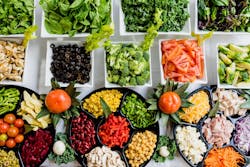Six Food Trends Of 2018 To Keep On Your Radar
Consumers desire different flavor profiles that suit their diversifying tastes, and look for brands that can meet these needs, according to FoodDive. Check out these six food trends that are dominating 2018.
1. Botanicals
Consumers are turning towards the increasingly popular segment of products that contain plants and flowers. These ingredients are showing up in foods as well as drinks.
2. Transparency
This clean movement, driven by consumers, has grown to include things such as packaging information, fewer artificial ingredients and more sustainable production and packaging. It has also extended beyond just labels to include product traceability, as consumers grow increasingly interested in knowing where their food comes and how it was made.
3. Ethnic Cuisine
Different types of cuisine, such as Asian and Middle Eastern flavors, have been increasingly popular in all segments. This can be seen in the spicy category which has grown since this trend took off. Millennials have a different palate and are demanding different options, favoring new flavors such as spicy, and regional types of food such as hummus.
4. Science-Based Foods
Food made from technology has been on the minds of consumers, as they are looking for more diversified options, made from things like plants and cell-cultured meat. The wave of food made from technology is becoming more popular, and it will be interesting to see how and where it takes off.
5. Sustainability
This wave of eating products that are made “root-to-stem" is only growing and becoming more important to consumers. They are increasingly involved in the battle against food waste, which can be linked again to transparency, as consumers want to know what the company’s corporate culture is, and understanding what’s in their food.
6. Indulgence Foods
Consumers are reaching for more premium indulgent items, such as chocolate. They are also interested in having indulgent foods that are higher in saturated fats, when some manufacturers are limiting sugar and sodium levels, in order to compensate for this.
